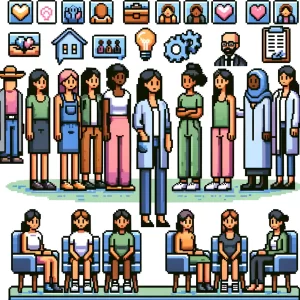
How Community Sports Help Vulnerable Adults
Have you ever wondered how something as simple as a community sports program can transform lives? For many adults in socially vulnerable positions, these programs offer more than just a chance to play sports—they provide a lifeline to better mental health, improved social skills, and a sense of belonging. Let’s dive into the fascinating findings of a recent study that sheds light on the crucial elements that make these community sports programs successful.
The Power of Sports in Vulnerable Communities
For adults facing challenges like low income, addiction, homelessness, and social isolation, finding ways to cope and thrive can be daunting. Community sports programs are designed specifically to reach these individuals, offering accessible activities that not only improve physical health but also foster essential life skills such as teamwork, discipline, and resilience.
Researchers embarked on a mission to uncover what makes these programs effective. By consulting three groups of stakeholders—social sports coaches, program coordinators, and social workers—they identified key elements that contribute to the success of community sports programs. These elements were systematically arranged using a method called Group Concept Mapping (GCM), a participatory approach that organizes thoughts and ideas to reveal patterns and priorities.
The Key Players: Social Sports Coaches
One of the standout findings was the pivotal role of social sports coaches. These individuals are not just there to teach sports; they are mentors, supporters, and role models. According to the social sports coaches themselves, the most effective elements include having strong interpersonal skills, being committed, and maintaining a balance between setting clear boundaries and giving participants freedom.
Creating a safe and positive atmosphere was highlighted as crucial. Coaches who listen to participants, show empathy, and provide fun and engaging activities make a significant impact. Interestingly, the program coordinators also emphasized the importance of coaches having sport-specific knowledge, while social workers stressed the protective nature of their role, ensuring participants are not overburdened.
The Importance of a Safe Sports Climate
Another critical element identified was the need for a safe and welcoming sports climate. A positive atmosphere where participants feel valued and supported can significantly enhance their experience and engagement. This safe environment allows participants to develop social skills, build confidence, and form meaningful connections.
The study found that creating a safe sports climate involves clear rules, structured activities, and a supportive environment where everyone feels included. This not only helps in retaining participants but also fosters a sense of community and belonging.
Organizational Elements and External Collaboration
Effective community sports programs also rely heavily on strong organizational elements and collaboration with external partners. Elements such as well-defined rules, proper scheduling, and accessible locations are essential for smooth operation. Additionally, building a network with social care organizations and other partners ensures the program’s sustainability and enhances its impact.
Program coordinators, in particular, highlighted the importance of collaboration, pointing out that working with external partners helps in participant recruitment, securing financial support, and creating a comprehensive support system for the participants.
Personal Development and Future Perspectives
The final theme that emerged from the study was participants’ personal development. The social workers especially emphasized this aspect, noting that community sports programs should not only focus on immediate benefits but also help participants set and achieve long-term goals. Providing opportunities for skill development, whether through sports or additional courses like computer or language classes, can have a lasting impact on participants’ lives.
Intrinsic motivation was identified as a key driver for success. Participants who are genuinely interested and motivated to engage in the program are more likely to reap the benefits and transfer the skills they learn to other areas of their lives.
Join the Conversation
Now, we’d love to hear from you! Have you ever participated in or witnessed the impact of a community sports program? What elements do you think are most important for their success? Share your thoughts and experiences in the comments below or join the conversation on social media.
Conclusion
The findings from this study highlight the profound impact that well-designed community sports programs can have on adults in socially vulnerable positions. By focusing on creating a safe and supportive environment, having committed and empathetic coaches, and fostering collaboration with external partners, these programs can offer more than just physical activity—they can provide a path to personal growth and improved well-being.
For public health practitioners and researchers, understanding these effective elements can help in designing and implementing programs that truly make a difference. By leveraging the insights from this study, we can continue to build and enhance community sports programs that empower individuals and strengthen communities.
Be Part of the Change – Get Weekly Updates!
Stay informed and connected. Subscribe for free and share this blog to make a difference in public health with others.



